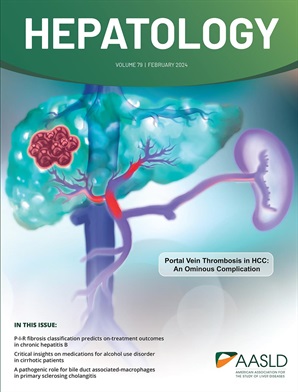Serum bile acid levels predict the development of portal hypertension and high-risk esophageal varices following successful Kasai in biliary atresia.
IF 15.8
1区 医学
Q1 GASTROENTEROLOGY & HEPATOLOGY
引用次数: 0
Abstract
BACKGROUND AIMS Biliary atresia can lead to portal hypertension (PH), high-risk esophageal varices (HRV) and liver transplantation, despite successful Kasai procedure (KP). Serum bile acids (sBA) can reflect residual cholestasis in patients with successful KP. We investigated the predictive value of sBA measured during the first year post-KP on the development of PH and HRV within 5 years post-KP. APPROACH RESULTS In this retrospective monocentric observational study, we included biliary atresia patients who underwent a successful KP, defined as a total serum bilirubin level of ≤25 μmol/L within 6 months post-KP, and in whom sBA were measured during the first year post-KP (n=60). We collected clinical, biological and digestive endoscopic data up to 5 years post-KP to assess the occurrence of PH and HRV. Predictive values of sBA were analyzed using receiver operating characteristic curves. sBA measured at a median time of 6 months (range: 4.5-9) and of 11 months (range: 9-12) post-KP, predicted PH at 3 and 5 years post-KP, with AUCs between 0.89 and 0.93 (p<0.0003) and the occurrence of HRV before 5 years post-KP with AUCs between 0.74 and 0.75 (p<0.04). sBA thresholds of 56 μmol/L and 30 μmol/L at a median time of 6 and 11 months post-KP, respectively, predicted HRV within 5 years post-KP with a sensitivity of 100%. CONCLUSION In biliary atresia patients with successful KP, sBA is an early biomarker predicting the development of PH and HRV within 5 years post-KP.血清胆汁酸水平预测成功Kasai治疗胆道闭锁后门脉高压和高危食管静脉曲张的发展。
背景:尽管Kasai手术(KP)成功,但胆道闭锁可导致门脉高压(PH)、高危食管静脉曲张(HRV)和肝移植。血清胆汁酸(sBA)可以反映KP成功患者的残余胆汁淤积。我们研究了kp后第一年测量的sBA对kp后5年内PH和HRV发展的预测价值。方法结果在这项回顾性单中心观察性研究中,我们纳入了成功接受KP的胆道闭锁患者,定义为KP后6个月内血清总胆红素水平≤25 μmol/L,并在KP后第一年测量sBA (n=60)。我们收集了kp后5年的临床、生物学和消化内窥镜数据,以评估PH和HRV的发生。采用受试者工作特征曲线分析sBA的预测值。在kp后6个月(范围:4.5-9)和11个月(范围:9-12)的中位时间测量sBA,预测kp后3年和5年的PH, auc在0.89 - 0.93之间(p<0.0003),在kp后5年之前发生HRV, auc在0.74 - 0.75之间(p<0.04)。在kp后6个月和11个月,sBA阈值分别为56 μmol/L和30 μmol/L,预测kp后5年内HRV的敏感性为100%。结论在KP成功的胆道闭锁患者中,sBA是预测KP后5年内PH和HRV发展的早期生物标志物。
本文章由计算机程序翻译,如有差异,请以英文原文为准。
求助全文
约1分钟内获得全文
求助全文
来源期刊

Hepatology
医学-胃肠肝病学
CiteScore
27.50
自引率
3.70%
发文量
609
审稿时长
1 months
期刊介绍:
HEPATOLOGY is recognized as the leading publication in the field of liver disease. It features original, peer-reviewed articles covering various aspects of liver structure, function, and disease. The journal's distinguished Editorial Board carefully selects the best articles each month, focusing on topics including immunology, chronic hepatitis, viral hepatitis, cirrhosis, genetic and metabolic liver diseases, liver cancer, and drug metabolism.
 求助内容:
求助内容: 应助结果提醒方式:
应助结果提醒方式:


